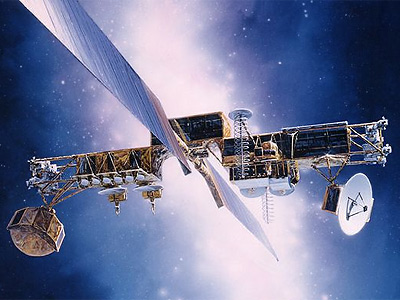Thank you very much for visiting Gunter's Space Page. I hope that this site is useful and informative for you.
If you appreciate the information provided on this site, please consider supporting my work by making a simple and secure donation via PayPal. Please help to run the website and keep everything free of charge. Thank you very much.
Milstar-2 1, 2, 3, 4 (Milstar 3, 4, 5, 6)

Milstar-2 [Northrop Grumman]
Milstar (Military Strategic & Tactical Relay) is the tactical and strategic multiservice satellite system designed to provide survivable communications for U.S. forces worldwide. The program is managed by the U.S. Air Force Space and Missile Center.
The Milstar-1 satellites carry a secure, robust low-data-rate (LDR) communications payload, and a crosslink payload that allows the satellites to communicate globally without using a ground station. The Milstar-2 satellites extend the communications capabilities to higher data rates by adding a medium-data-rate (MDR) payload. The Milstar-1 and -2 satellites are fully interoperable for LDR communications and crosslinks.
Boeing has the prime responsibility for supplying the MDR and crosslink payloads to prime contractor Lockheed Martin Missiles and Space Company. BSS subcontracts with TRW Space and Electronics Group for the MDR antennas and digital subsystem, and provides portions of the LDR payload under subcontract to TRW.
Milstar satellites use a unique bus, consisting of three boxes, which are folded during launch and deploy in orbit.
The Milstar system provides uplink communications at extremely high frequency (EHF), 44 GHz, and ultrahigh frequency (UHF), 300 MHz, and downlink communications at super-high frequency (SHF), 20 GHz, and UHF, 250 MHz. The crosslinks operate in the 60 GHz region. Survivability and endurability requirements are satisfied by anti-jam, hardening and system autonomy features.
- LDR Payload:
The LDR payload offers nearly 200 user channels and relays coded teletype and voice messages at data rates of 75 to 2400 bits per second. - MDR Payload:
The MDR payload provides secure, jam-resistant communications services through unique onboard signal and data processing capabilities. It sends real-time voice, video and data to military personnel in the field at rates up to 1.5 Mbps. The payload uses a 32-channel EHF uplink and an SHF downlink. The MDR payload dynamically sorts incoming data and routes them to the proper downlinks to establish networks and provide bandwidth on demand. If necessary it passes the data on to another satellite via crosslink.
The MDR antenna coverage subsystem consists of eight narrow spot beam antennas provided by TRW: two narrow spot beams with nulling capabilities (nuller antennas) and six distributed user coverage antennas (DUCAs), each supporting two-way communications.
In contrast to commercial communications satellites, whose beams can cover entire continents, Milstar's beams are very narrow, providing less opportunity for enemy detection and penetration. The nuller antennas resist jamming from within their respective coverage areas by changing their gain patterns when a jamming signal is detected. The DUCAs provide high gain/low sidelobes for distributed users. - Crosslink Payload:
Like a handshake in space, crosslinks provide rapid, ultra-secure communications by enabling the satellites to pass signals to one another worldwide while requiring only one ground station on friendly soil. The crosslink payload provides V-band (60 GHz) data communications between Milstar satellites for both the MDR and LDR payloads. This includes modulation and demodulation of the data, upconversion, amplification for transmission and downconversion.
Originally the full Milstar system was to contain ten satellites, which were cut to four.
Milstar-2 1 was launched on 30 April 1999, but was stranded in a into a lower orbit than had been planned, and damaged by deployment at excessive rates due to a database error affecting the attitude control system of the Centaur upper stage. It could not be raised into its operational orbit due to fuel limitations. Its orbit was raised as much as possible to increase the expected lifetime and then it was permanently turned off after 10 days.
Milstar was succeded by the AEHF (Advanced Extreme High Frequency Satellite) satellites.
| Nation: | USA |
|---|---|
| Type / Application: | Comsat |
| Operator: | US Air Force (USAF) |
| Contractors: | Lockheed Martin (Bus), TRW (LDR payload), Hughes / Boeing (MDR payload) |
| Equipment: | LDR, MDR and Crosslink payloads |
| Configuration: | Milstar Bus |
| Propulsion: | 2 × R-4D-12 |
| Power: | 2 deployable solar arrays, batteries |
| Lifetime: | 10 years |
| Mass: | 4500 kg (design) |
| Orbit: | GEO |
| Satellite | COSPAR | Date | LS | Launch Vehicle | Remarks | |
|---|---|---|---|---|---|---|
| Milstar-2 1 (Milstar 3, USA 143) | 1999-023A | 30.04.1999 | CC LC-40 | f | Titan-4(01)B Centaur-T | |
| Milstar-2 2 (Milstar 4, USA 157) | 2001-009A | 27.02.2001 | CC SLC-40 | Titan-4(01)B Centaur-T | ||
| Milstar-2 3 (Milstar 5, USA 164) | 2002-001A | 16.01.2002 | CC SLC-40 | Titan-4(01)B Centaur-T | ||
| Milstar-2 4 (Milstar 6, USA 169) | 2003-012A | 08.04.2003 | CC SLC-40 | Titan-4(01)B Centaur-T | ||
| Milstar-2 5 (Milstar 7) | - | cancelled | CC SLC-40 | Titan-4(01)B Centaur-T | ||
| Milstar-2 6 (Milstar 8) | - | cancelled | CC SLC-40 | Titan-4(01)B Centaur-T | ||
| Milstar-2 7 (Milstar 9) | - | cancelled | CC SLC-40 | Titan-4(01)B Centaur-T | ||
| Milstar-2 8 (Milstar 10) | - | cancelled | CC SLC-40 | Titan-4(01)B Centaur-T |
References:
- Boeing: Milstar II
- Los Angeles Air Force Base: Milstar fact sheet
